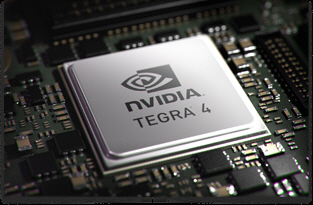Yesterday during the first day of the 2013 Consumer Electronics Show (CES), NVIDIA introduced the NVIDIA Tegra 4, its newest and self-proclaimed world's fastest mobile processor, which it says delivers record-setting performance and battery life, and which it fully believes will power smartphones and tablets, gaming devices, auto infotainment and navigation systems and PCs.
Codenamed "Wayne" during its development, the Tegra 4 features 72 custom NVIDIA GeForce GPU cores, which deliver six times the GPU horsepower of the Tegra 3. That translates into the delivery of a much more realistic gaming experience and speedy support for much higher resolution displays. NVIDIA notes that the Tegra 4 is the first quad-core application of ARM's most advanced CPU core, the Cortex-A15, which delivers 2.6 times faster Web browsing and true breakthrough performance for applications.
We noted above that the Tegra 4 being the "world's fastest mobile processor" is self-proclaimed, but the specifications certainly point to this being true. What is both amusing and interesting to us is that NVIDIA has actually managed to trump its own exciting news here as yesterday it also unveiled Project SHIELD, it's exciting and totally new, super high-end and wireless mobile game controller. Project SHIELD is new to NVIDIA both as a product and as a new direction for the company, as Project SHIELD is also NVIDIA's first true consumer- and mobile consumer-targeted product.

The Tegra 4 will offer exceptional graphics processing, lightning-fast Web browsing, stunning visuals and new camera capabilities delivered through "computational photography." The new Tegra 4 also enables worldwide 4G LTE voice and data support through NVIDIA's fifth-generation NVIDIA Icera i500 processor, which the company offers as an optional chipset. More efficient and 40 percent the size of conventional modems, the i500 delivers four times the processing capability of its predecessor.
A list of the key features the Tegra 4 delivers includes the following:
- GeForce GPU with 72 custom cores.
- Quad-core ARM Cortex-A15 CPU, plus a 2nd Generation Battery Saver Core.
- Computational Photography Architecture.
- LTE capability with optional Icera i500 chipset.
- 4K ultra high definition video support.
We have no doubt what so ever that these lists of capabilities will all prove to be an accurate assessment of the capabilities of any mobile devices built with the Tegra 4. But we are probably most specifically interested in the Tegra 4's new Computational Photography Architecture, which NVIDIA claims will automatically delivers high dynamic range (HDR) photos and video by fusing together the processing power of the GPU, CPU and the camera's image-signal processor. Its HDR capability captures images, including those taken with a flash, the way they are seen by the human eye - with detail in both bright and dark areas.
Recently we ran an article that highlights the fact that there are now over a billion mobile cameras out there. What we would love to see is a greatly improved smartphone photography capability that changes the dynamic from what is now a photography experience more closely related to cheap digital point and shoot cameras to one much more closely aligned with higher end photography capabilities. NVIDIA's new Computational Photography Architecture masy actually get us there.
The Tegra 4 is also designed from the ground up to deliver maximum energy efficiency. The new processor includes a second-generation battery saver core for low power during standard use, and PRISM 2 Display technology to reduce backlight power while delivering superior visuals. As a result, the Tegra 4 consumes up to 45 percent less power than its Tegra 3 predecessor in common use cases.
That power consumption savings translates into as much as 14 hours of HD video playback on any smartphone built on the Tegra 4. When the Tegra 4 is also coupled with the efficient Icera i500 LTE modem, the ability to stream video over the cellular network will also prove to offer unprecedented power capabilities that will greatly improve the user experience.
"Tegra 4 provides enormous processing power and efficiency to power smartphones and tablets, gaming devices, auto systems and PCs," says Phil Carmack, senior vice president of the Tegra business at NVIDIA. "Its new capabilities, particularly in the area of computational photography, will help improve a whole range of existing products and lead to the creation of exciting new ones."
We look forward to seeing the first wave of new smartphones and tablets built on the Tegra 4. Meanwhile, we'll also look to getting our hands on the new Project SHIELD game controller - we're not hard core gamers by any stretch of the imagination, but the gadget sounds like it will provide some definite mobile fun. The Tegra 4, however, should prove itself the worthier news - even if NVIDIA managed to overshadow it with Project SHIELD.
Edited by
Allison Boccamazzo
 QUICK LINKS
QUICK LINKS